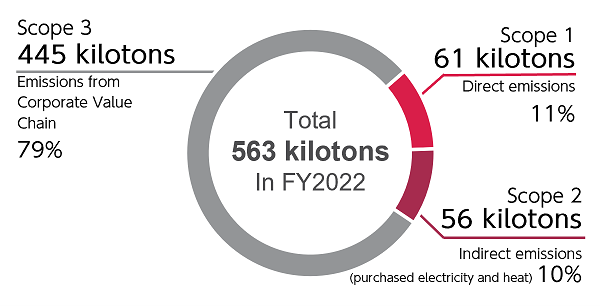We are committed to protecting life and the natural world in all its glory
Astellas has embraced the sustainable enhancement of enterprise value as its corporate mission. To fulfill this mission, Astellas seeks to be a chosen and trusted enterprise by all stakeholders, including patients, shareholders, employees, and the global community. The Astellas Charter of Corporate Conduct contains the following principles on Environment, Health and Safety (EHS): “We shall respect our employees’ human rights, individuality, and differences, promote diversity in the workplace, and provide a safe and rewarding work environment,” and “Recognizing that harmony between the global environment and our business activities is a prerequisite to our corporate existence, we shall take proactive measures to conserve the global environment.” These principles require employees to conduct themselves based on high ethical standards in EHS fields, among other areas. In the environment and occupational health and safety pages, Astellas will disclose information on its measures to sustainably enhance enterprise value through EHS.
Message
Astellas contributes to the development of society’s sustainability through its business activities and related initiatives. Since the strengthening of efforts to improve sustainability was one of Astellas' strategic goals newly established in Corporate Strategic Plan 2021 (CSP2021), each department has begun a cycle of thinking about and implementing environmental themes in cooperation with other departments.
Since fiscal 2021 for some products in Japan, Astellas has been using blister sheets, which are a tablet packaging container made of biomass plastic made from plant-derived raw materials. This was the first use of biomass plastic in blister sheets in the world, and in February 2023, Astellas received the Minister of Environment Award of the 5th Japan Open Innovation Prize (sponsored by the Cabinet Office) in recognition of the open innovation that led to its realization.
Regarding progress of efforts on climate change measures, Astellas reviewed greenhouse gas (GHG) emission targets set under the Environmental Action Plan and in January 2023 underwent a validity assessment by the Science Based Targets initiative (SBTi). Target reviews are required every five years, but Astellas conducted the review one year ahead of schedule and changed the reduction targets that were set based on the 2℃ target (Paris Climate Agreement). The new targets are science-based targets and have been approved towards achieving the targets of 1.5 ℃ (Scope 1 and 2) and well-below the 2℃ targets (Scope 3) of the Paris Agreement. In February 2023, Astellas also announced its commitment to achieve Net Zero GHG emissions in business activities by 2050.
As a responsible member of society, Astellas will continue to improve environmental sustainability and disclose information transparently, as well as act to reduce GHG emissions to realize a sustainable society.
・Astellas Environment, Health & Safety Policy
Interaction between Astellas and the Environment (Results for Fiscal 2022)
As detailed below, the business activities of Astellas impinge on the environment throughout all the fields in which it operates, including research, manufacturing, sales, and product distribution.
INPUT  |
OUTPUT | ||
|---|---|---|---|
| Energy *1 | GHGs *1  |
||
| Electricity |
227,486 MWh |
Scope 1 *4 |
61,171 tons |
| City gas |
19,331 thousand m3 |
Scope 2 |
56,473 tons |
| LPG | 1,002 tons | Pollutants (atmosphere) |
|
| LNG | 748 tons | NOx *5 | 18 tons |
| Kerosene | 22 kiloliters | VOC *5
|
23 tons |
| Diesel oil | 1,561 kiloliters | Pollutants (water body) *5 | |
| Gasoline | 3,776 kiloliters |
BOD |
9 tons |
| Purchased heat (hot/cold water) |
4,330 GJ |
COD | 19 tons |
| Purchased heat (steam) | 21,802 GJ | Water discharge *2 |
|
| Other renewable energy | 45,447 GJ | Water discharge | 6,498 thousand m3 |
| Resources | Waste material |
||
| Water *2 | 6,868 thousand m3 | Volume of waste generated *2 | 13,566 tons |
| Raw materials and consumables (by weight) *3 |
4,169 tons | Landfill volume *3 | 55 tons |
| Raw materials and consumables (by volume) *3 |
354,100 kiloliters | ||
*1 All Astellas business facilities
*2 All Japanese facilities, and all production facilities and R&D sites outside of Japan. Volume of water discharge from non-Japanese sites was equivalent to that of withdrawal.
*3 All Japanese business facilities
*4 Non-energy related GHG emissions are not included. The CO2 equivalent of fluorinated gases from production sites (global) and R&D sites (Japan) was 2,304 tons.
*5 All production facilities and R&D sites in Japan
Indirect GHGs (Scope3) 
| Upstream Scope3 emissions | ||
|---|---|---|
| Category | GHG emissions | |
| 1 | Purchased goods and services | 219,559 tons |
| 2 | Capital goods | 168,011 tons |
| 3 | Fuel and energy related activities (not included in Scope1 and Scope2) | 30,096 tons |
| 4 | Transportation and distribution | 16,528 tons |
| 5 | Waste generated in operation | 1,281 tons |
| 6 | Business travel (by airplane) | 6,940 tons |
| 7 | Employee commuting | 2,119 tons |
| 8 | Leased assets | Not relevant |
| Downstream Scope3 emissions | ||
| Category | GHG emissions | |
| 9 | Transportation and distribution | Not relevant |
| 10 | Processing of sold products | Not relevant |
| 11 | Use of sold products | Not applicable |
| 12 | End-of-life treatment of sold products | 424 tons |
| 13 | Leased assets | 48 tons *1 |
| 14 | Franchises | Not relevant |
| 15 | Investments | Not relevant |
*1 Part of Astellas facilities are leased to another company.
Scope 3 Category 2 data was re-calculated because the former calculation method had been applied partially. Please find Scope 3 emissions (past 3 years) for the detail.
GHG Emissions Throughout the Value Chain 
GHG emissions associated with Astellas’ business activities amounted to 563 kilotons globally. Astellas is monitoring the greenhouse gas emissions associated with the use of almost all its facilities and sales fleets.
Scope 3 Category 2 data was re-calculated because the former calculation method had been applied partially. Please find Scope 3 emissions (past 3 years) for the detail.
In addition to Scope 1 and Scope 2 emissions, Astellas continues working to monitor Scope 3 emissions. In fiscal 2022 Astellas began disclosing GHG emissions from purchased goods and services (Category 1), including those from overseas production facilities, and GHG emissions from the transportation of products and other goods for which Astellas is the consignor (Category 4) from bases sites outside Japan.


